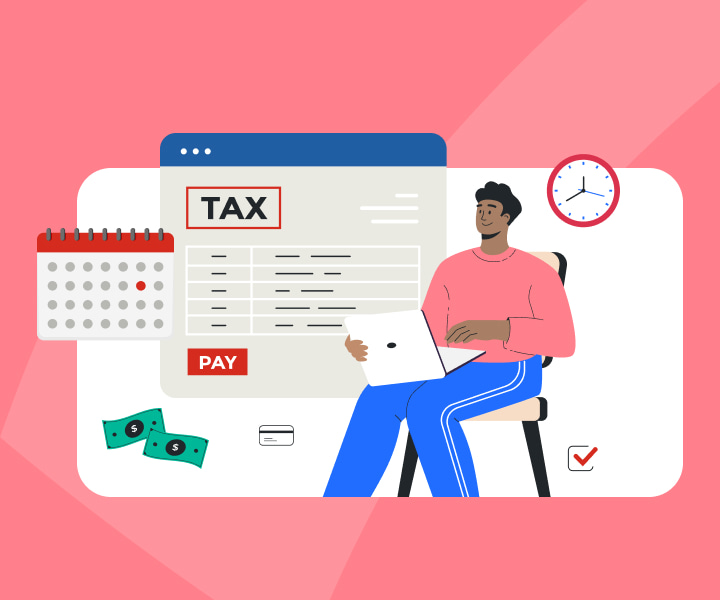Get all the expert help you need for only $20 when you’re 25 or younger with TurboTax
4 Biggest Tax Mistakes Gen Z Side Hustlers Make
TurboTax Canada
January 23, 2024 | 6 Min Read
Updated for tax year 2025

Life can be expensive. That’s why many Gen Zers have a side hustle—or two. Whether you’re driving for a ride-share app, selling your crafts online, or building a freelance business, side hustles can help pay bills, save for big purchases, or just make life a little easier.
But the last thing you want if you’re out there hustling is to make a mistake on your side- gig taxes. Luckily, it’s easy to avoid the most common mistakes people make on side-hustle taxes. We’ll give you some simple tips to help you be proactive when it comes to your taxes, including making sure you take all the side-hustle tax deductions you’re entitled to!
Key Takeaways
- You need to declare and pay taxes on self-employed income, using Form T2125.
- Business expenses can be deducted from your side-hustle income, including supplies, home-office expenses, and computers.
- A best practice is to calculate the taxes you owe throughout the year and put aside that money so you’ll feel prepared and ready to pay your tax bill!
Do you have to pay taxes on side hustles?
Yes, you do and a great rule to remember is that if you’re earning money in any way, the Canada Revenue Agency (CRA) needs to know about it. That includes the income you’re making on whatever kind of side work you’re doing to bring in extra money—whether you’re DJing on the weekends at weddings or selling baked goods at farmers markets.
Essentially, “side hustle” is just another word for self-employed income. Rather than getting a paycheque from an employer, you make money directly from clients or customers. That income needs to be claimed on your tax return and you need to ensure you pay your side-gig taxes, otherwise you could end up on the hook for back taxes and penalties.
How to report income from a side hustle
Filing taxes for your side business is easy. You need to fill out a T2125 form, which is part of the T1 General Income Tax and Benefit Return.
The T2125 form will ask you details about your side hustle, including your income and expenses. After calculating your net income or loss from your side hustle on the T2125, you’ll need to transfer this amount to the appropriate line on your T1 General Income Tax and Benefit Return. That way, it will get added to your income from your day job (and other sources) to determine how much you owe in taxes.
Mistake 1: Not taking your side-hustle tax deductions
The best part of having a side gig is being able to take side-hustle deductions. Not taking or maximizing your deductions means you’ll have to pay more side-hustle taxes than you might otherwise need to. Here’s what you’ll want to know:
Deductible expenses
- You can deduct most expenses that are connected to your side hustle. This includes things such as office supplies, equipment, advertising, professional fees, travel, and more.
- Keep all your receipts as well as a running total of what you’ve spent on your side hustle throughout the year.
Home-office deductions
- You might be able to claim some of your housing expenses toward your side hustle, including utilities, insurance, property taxes, rent, mortgage interest, or maintenance costs.
- Make sure you meet the criteria for the deduction and calculate your work area and time used for work accurately.
Special deduction rules
- Some expenses have specific rules that you need to follow.
- Meals and entertainment are generally deductible at only 50%.
- Mileage for business-related travel also gets calculated in a very specific way.
- Capital expenses like desks or computers can’t be claimed all in one year; they have to be claimed over multiple years depending on the type of capital expense it is.
Mistake 2: Not setting money aside for your side-gig taxes
One recipe for financial disaster when you’re a side hustler is to spend all the money you make and not set any aside for your side-hustle taxes at the end of the year. For many, having a big, unexpected side-gig tax bill can lead to significant financial pain—or, worse, tax debt.
While some people who are self-employed have to pay their side-gig taxes quarterly, many pay annually. If you’re doing that, consider calculating how much you’re likely to owe and putting aside that amount. Here’s how to do it:
Step 1: Determine your tax rate
- To determine your tax rate, first check what your tax rate is after your regular income from your day job. For example, if you make between $57,375 and $114,750, then your federal tax rate for 2025 will be 20.5%, and your provincial tax rate will depend on your province’s tax brackets.
- Let’s say you make $70,000 at your job and you live in British Columbia. That means you’ll pay 7.7% in provincial taxes, since you make between $49,279 and $98,560. This means a combined tax rate of 28.2% (20.5% +7.7%) in taxes on additional income from your side hustle.
Step 2: Calculate your side-hustle taxes monthly
- Now you need to add up what you make in a month in your side hustle. If you make $2,000 a month after business expenses, you’ll need to figure out how much is owed in taxes. At a combined marginal tax rate of 28.2%, you’ll multiply your income by 0.282 ($2,000 x 0.282) to determine you need to put aside $564 a month for your taxes.
Step 3: Adjust if you enter a different tax bracket
- Make sure to adjust your calculations if you break into a new tax bracket during the year. At that point, you’ll have to start setting aside more money for your taxes. For example, if you were to earn more than $95,875 from your combined income (that is, day job plus side gig) and you’re based in British Columbia, you’d have to start setting aside 10.5% in provincial taxes, making your tax rate 31% instead of 28.2%.
Step 4: Put your tax money aside
- Now that you’ve calculated how much you’ll owe, make sure to put that money in a different account, so you won’t accidentally use it on something fun.
Mistake 3: Not reporting side-hustle income in the past
Now that you’ve learned about the necessities of side-gig taxes, you might have realized you made a mistake on a tax return already filed by not declaring your side-hustle income. Not a big deal. It’s fixable! You’ll just have to go back and correct past tax returns.
Correcting past tax returns through ReFile
- So, how do you correct your tax return? You’ll need to amend the amount entered on specific lines of your return. You can make those adjustments online through the CRA’s My Account service for the previous 10 tax calendar years.
- Or you can also then use the ReFILE online service that lets individuals and EFILE service providers make changes to tax returns online. You’ll need to do this through the tax professional you originally used or the do-it-yourself tax preparation service used in your original filing.
Correcting past tax returns by mail
- You can also change your return by mail, by completing Form T1-ADJ, T1 Adjustment Request and sending the CRA all supporting documents for the change, including the original assessment.
Potential penalties
You might have to pay a penalty for failing to report income. However, if you voluntarily disclose the income, the CRA might grant you relief from the penalty. The penalty amount is usually whichever is less: 10% of the amount you failed to report or 50% of the difference between the amount you failed to report and the tax withheld from the amount you failed to report.
Mistake 4: Not registering for GST/HST
You know about the Goods and Services Tax (GST) and the Harmonized Sales Tax (HST) because you pay it on your purchases. But did you know that you might need to charge it to your customers?
When you have to register for GST/HST
- If you make more than $30,000 from your side gig in four consecutive quarters (that is, 12 months), you’ll have to register for GST/HST and start charging it to your clients or customers.
How much you need to charge
- If you live in a province that hasn’t harmonized PST and GST into HST—for example, Alberta, British Columbia, Manitoba, Northwestern Territories, Nunavut, Quebec, Saskatchewan, and the Yukon—you’ll need to charge 5% GST on all your sales made within Canada. Be sure to also check provincial or territorial requirements to see if you need to register for a PST number and charge PST.
- If you’re in a province with HST, you have to charge whatever your province’s HST rate is on sales within Canada, which varies from 13% in Ontario to 15% in New Brunswick, Newfoundland and Labrador, Nova Scotia, and Prince Edward Island.
- If you sell products or services to buyers outside Canada, you typically do not need to charge GST/HST.
Why some people voluntarily register for GST/HST
- You can voluntarily register for a GST/HST number and start charging sales tax on goods and services you sell via your side gig even if you make less than $30,000.
- Why would you want to do that? Because then you can claim input tax credits (ITCs). That means if you are buying supplies for your side hustle business, you can claim the GST/HST you paid for supplies and take those funds out of the GST/HST you collected from your customers.
When you need to pay your GST/HST
- Depending on how much you make, you might have to remit your GST/HST annually or quarterly. Everyone who has a GST/HST number, however, has to file an annual GST/HST tax return.
Keep more of your hard-earned money
Find unique deductions personalized to your line of work.
Get StartedDo you have to pay taxes on side hustles?
How to report income from a side hustle
Mistake 1: Not taking your side-hustle tax deductions
Mistake 2: Not setting money aside for your side-gig taxes
Step 1: Determine your tax rate
Step 2: Calculate your side-hustle taxes monthly
Step 3: Adjust if you enter a different tax bracket
Step 4: Put your tax money aside
Mistake 3: Not reporting side-hustle income in the past
Correcting past tax returns through ReFile
Correcting past tax returns by mail
Mistake 4: Not registering for GST/HST
When you have to register for GST/HST
Related articles

© 1997-2024 Intuit, Inc. All rights reserved. Intuit, QuickBooks, QB, TurboTax, Profile, and Mint are registered trademarks of Intuit Inc. Terms and conditions, features, support, pricing, and service options subject to change without notice.
Copyright © Intuit Canada ULC, 2024. All rights reserved.
The views expressed on this site are intended to provide generalized financial information designed to educate a broad segment of the public; it does not give personalized tax, investment, legal, or other business and professional advice. Before taking any action, you should always seek the assistance of a professional who knows your particular situation for advice on taxes, your investments, the law, or any other business and professional matters that affect you and/or your business.









